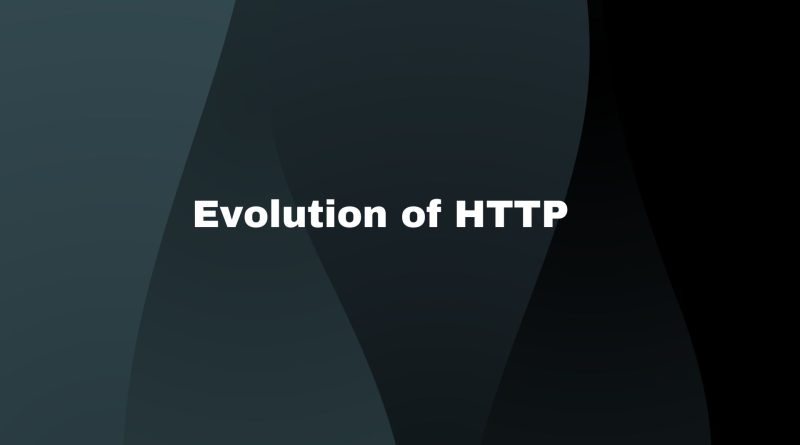The Evolution of HTTP: How the Internet Became What It Is Today
The internet has come a long way in the last few decades. It has gone from being an obscure technology to becoming a part of everyday life, and much of this success is due to one protocol: Hypertext Transfer Protocol (HTTP). HTTP was first developed in 1989 as a simple method for transferring files across networks, but it quickly became the foundation on which the modern web was built.
Today, nearly every website uses HTTP in some form or another, making it essential for anyone who wants to understand how the web works. In this article, we will explore the history and evolution of HTTP, tracing its development from humble beginnings to its current status at the backbone of the internet. We’ll also take a look at what makes HTTP so powerful and why it’s still so important today.
Origins Of HTTP
HTTP is an integral part of the modern internet, but its roots date back to the early days of computer communication. In 1989, Tim Berners-Lee at CERN developed a protocol called HyperText Transfer Protocol (HTTP) and wrote it into a program they used to exchange information between computers. HTTP was based on two existing protocols which allowed for document transfer: File Transfer Protocol (FTP) and Telnet. The main difference with HTTP was that it provided interactive access to documents using hypertext links rather than just downloading them as FTP did.
The first version of this protocol, known as HTTP/0.9, lacked many features found in later versions such as persistent connections or request headers; instead, all requests were GETs with no data sent along with them. It also didn’t have any security measures whatsoever and had limited support for different types of content like images or videos. Despite these limitations, it quickly became popular due to its simplicity and widespread use among researchers who needed to share scientific papers easily over the internet.
By 1991, almost half of all web traffic was already using some form of HTTP. This spurred further development of the HTTP protocol and by 1993 we saw the release of both versions 1.0 and 1.1 which brought about basic authentication, better error handling, and more support for different media types – paving the way for what we now know as the World Wide Web today. As we move onto examining ‘HTTP/0.9’, let’s take a closer look at how far this technology has come since then…
HTTP/0.9
In 1990, HTTP/0.9 was released as the original version of Hypertext Transfer Protocol (HTTP). This protocol allowed for basic communication between a client and server in order to transfer information over the internet. It supported one-way requests from a single web page with no support for HTTP headers or any other type of data exchange protocols.
The only command that could be used by clients using this protocol was GET, which meant they could only retrieve data from the server. The response sent back by servers had minimal formatting, consisting of plain text files with no HTML tags or images included. Furthermore, it lacked features such as caching and security measures present in more modern versions of HTTP.
This initial release provided a simple foundation upon which further development would build on in subsequent releases. It set the stage for further advancements that eventually led to the development of HTTP/1.0 and later updates like HTTP/1.1, HTTP/2 and HTTP/3, ultimately providing an efficient way to communicate across networks on the internet today.
HTTP/1.0
HTTP/1.0 was released in 1996 and is the first version of HTTP to support persistent connections, which allow multiple requests between a web server and browser without having to reestablish a new connection each time. This allowed for faster loading times as it eliminated the need to set up a brand-new connection with every request from the client. It also featured more efficient data transfer methods such as chunked encoding, allowing large files or images to be sent quickly over networks. Furthermore, HTTP/1.0 introduced status codes and more HTTP methods for better communication between clients and servers about page loading statuses; these codes are still used today.
Additionally, this version of HTTP added virtual hosting capabilities so that one single IP address could host multiple domain names on a single machine—a feature that became increasingly important as websites began relying more heavily on shared hosting services. Security features were also improved by adding basic authentication protocols to help protect sensitive information being requested across the network.
These advances made HTTP/1.0 an essential building block for modern web technologies and served as an important step toward future versions of the protocol like HTTP/1.1 that would shape how we use our devices to access online content today.
HTTP/1.1
HTTP/1.1 was the successor to HTTP/1.0 and saw many improvements over its predecessor, such as increased performance and improved communication between servers and clients. It also introduced new features like persistent connections, byte-serving, caching mechanisms, content negotiation, chunked transfer encoding, and more. These enhancements greatly increased web page loading times for users by reducing latency which has resulted in a much smoother browsing experience compared to earlier versions of the protocol.
The biggest change from previous protocols was that HTTP/1.1 allowed multiple requests within one connection – eliminating the need to open a separate TCP connection each time data needed to be transferred back and forth between client and server. This meant faster page loading speeds since only one connection would be used instead of multiple ones per single request. It also reduced network congestion resulting in better overall performance on both sides of the transaction.
Overall, HTTP/1.1 provided an important upgrade that enabled websites and services to grow significantly larger than they had previously been capable of while continuing to provide reliable user experiences with high levels of speed and efficiency – paving the way for future generations of this popular protocol including upcoming advancements like HTTP/2.0…
HTTP/2.0
Introduced in 2015, HTTP/2 is the latest major version of Hypertext Transfer Protocol (HTTP). It builds on the successful features of HTTP/1.1, while adding several performance-enhancing enhancements to make it more efficient and secure.
At its core, HTTP/2 makes use of multiplexing over a single TCP connection with header compression and binary framing, allowing for faster data transfers than previous versions. Additionally, HTTP/2 incorporates support for server push technology which enables web servers to send resources to clients without requiring them to request them first. This allows pages to be served quicker as content can be preloaded before the user requests it. These improvements are especially beneficial when loading large images or other multimedia components that take longer to download due to their size.
HTTP/2 also introduces an increased focus on security by mandating encryption via HTTPS connections only. This ensures all communication between browsers and websites is encrypted and private from malicious actors attempting to intercept sensitive information such as passwords or credit card numbers. All in all, these changes have made using HTTP much easier and faster than ever before and provide a strong foundation for further advancements in the future.
As internet speeds continue to increase and new technologies enter the market, so too has there been progress towards creating an even better protocol: HTTP/3.0.
HTTP/3.0
HTTP/3.0 is the latest version of the Hypertext Transfer Protocol (HTTP), and it has been designed to improve performance, reliability, and security. It introduces several new features that take advantage of modern technologies like Network Address Translation (NAT) traversal, TLSv1.3 encryption, and QUIC transport protocol support. This makes HTTP/3.0 not only faster than previous versions but also more secure for data transfers across networks.
In addition to these improvements, HTTP/3.0 includes a congestion control algorithm that can help reduce latency by managing network traffic in an efficient manner. Furthermore, stream multiplexing allows multiple requests from different clients to be sent over a single TCP connection simultaneously without sacrificing speed or bandwidth. This means that webpages will load much quicker when using this protocol compared to other methods such as WebSocket or AJAX requests.
Overall, HTTP/3.0 provides significant advantages over its predecessors with improved performance, reliability, and security features that make it ideal for today’s internet applications. As the future of communication continues to evolve, we are likely to see even greater advancements in this technology as developers push the boundaries of what is possible within the world wide web. Transitioning into WebSocket Protocol now, let’s explore how this powerful tool adds another layer of functionality when used alongside HTTP protocols…
Websocket Protocol
The WebSocket protocol is a powerful tool that enables the communication between web clients and servers. It allows for full-duplex communication via a single TCP connection, making it an ideal choice for real-time data transfer applications such as chat rooms or multi-player games. Here are three key points to consider when discussing the advantages of this technology:
1) The WebSocket protocol facilitates faster transmission speeds than traditional HTTP requests by keeping open connections alive over multiple transactions;
2) Its bidirectional nature eliminates the need for many additional requests from both client and server sides;
3) Security protocols can be implemented more easily with WebSockets due to its built-in support for SSL encryption. Overall, these features make WebSockets the perfect fit for modern interactive web applications where speed, reliability, and security are paramount.
As we move towards an increasingly connected online world, Websockets will likely remain at the forefront of internet communications going forward. Consequently, understanding their importance in our technological landscape is essential.
Future Of HTTP
The future of HTTP is an exciting prospect. As more advanced technologies become available, the protocol continues to evolve in order to accommodate them. It’s widely accepted that HTTP/2 will be a major step forward for both increased performance and security. This new version of the protocol was designed from the ground up and can take advantage of multiplexing, header compression and server push-all features which are not supported by its predecessor.
By taking advantage of these advancements, web developers will be able to create faster applications with improved user experiences. Additionally, due to enhanced encryption techniques such as TLS 1.3, users can expect much better data privacy when using HTTP/2 compared to older versions. The focus on efficiency also means that websites should load quicker than before; this could mean fewer dropped connections or pages loading faster even on slower networks.
All in all, it looks like we’re set for a bright future with regard to our relationship with the world wide web through HTTP/2 technology. With its impressive capabilities comes the significant potential for further improvements in areas such as speed and security – something every internet user is sure to benefit from!
Conclusion
HTTP has come a long way since its conception in 1991, and the current version of HTTP (3.0) provides an impressive range of features to ensure that web applications are secure, reliable, and accessible across multiple devices and platforms. The WebSocket Protocol was also introduced as an additional layer on top of the existing HTTP architecture to enable real-time communication between servers and clients without needing to refresh or reload pages.
Looking ahead, there is potential for more improvements and enhancements to be made to HTTP technology – such as support for IPv6 addresses, improved performance via header compression, and better security protocols – which will help create faster, more secure websites with even greater capabilities than before. With continued development by both industry professionals and open-source initiatives alike, it’s likely that future iterations of the Hypertext Transfer Protocol will remain at the forefront of modern web architectures for years to come.
In conclusion, while HTTP has been around for almost three decades now, its evolution over time shows no signs of slowing down any time soon. As new technologies become available and more advanced use cases arise from them, we can expect further changes to occur within this important protocol going forward.



